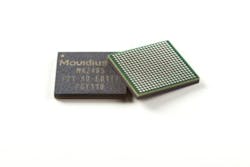Intel introduces Movidius Myriad X VPU with neural compute engine for deep learning
Intelhas announced the release of the Movidius Myriad X vision processing unit (VPU), which is a system-on-chip that features a neural compute engine for accelerating deep learning inferences at the edge.
The neural compute engine is an on-chip hardware block specifically designed to run deep neural networks at high speed and low power without compromising accuracy, enabling devices to see, understand and respond to their environments in real time, according to Intel, which says that the Myriad X architecture is capable of 1 TOPS (trillion operations per second) of compute performance on deep neural network inferences.
"We’re on the cusp of computer vision and deep learning becoming standard requirements for the billions of devices surrounding us every day," said Remi El-Ouazzane, vice president and general manager of Movidius, Intel New Technology Group. "Enabling devices with humanlike visual intelligence represents the next leap forward in computing. With Myriad X, we are redefining what a VPU means when it comes to delivering as much AI and vision compute power possible, all within the unique energy and thermal constraints of modern untethered devices."
Furthermore, the device can deliver more than 4 TOPS of total performance, and combines imaging, visual processing, and deep learning inference in real time. The device also features programmable 128-bit VLIW vector processors, increased configurable MIPI lanes (16), enhanced vision accelerators (over 20), and 2.5 MB of homogenous on-chip memory, which will allow for up to 450 GB/s of internal bandwidth.
Intel’s Movidius Myriad X, according to El-Ouazzane, would be perfectly suited for deployment in autonomous devices, as the company has removed the time and power constraints of communication with the cloud and enabled deep learning at the device level.
"This is where the power of the VPU comes in – the Movidius platform is specifically designed to meet the challenges of autonomous devices. Our tiny VPUs put visual intelligence directly onboard the device while delivering industry-leading compute performance at an ultralow power threshold."
He continued, "This is the day I have looked forward to since we were welcomedinto the Intel family nearly one year ago – how time flies. In working across Intel’s diverse areas of expertise – from the AI Product Group and IoTG to the Intel Labs and RealSense teams, we have been able to give scale to our technology and push the performance of deep learning at the edge to bring Myriad X to the world in a form that is better and faster than I ever imagined."
By now, it should be abundantly clear that Intel has placed significant emphasis on both autonomous vehicles and deep learning technologies, as evidenced by recent product launches, investments, statements, and so on. Here are some recent headlines that help to tell the full story:
- Intel acquires Mobileye, plans to deploy 100 autonomous vehicles later this year
- Deep learning device from Intel enables artificial intelligence programming at the edge
- Intel: Autonomous driving will create $7 trillion passenger economy
- Intel to invest $250 million for autonomous vehicle technology
View more information on the Movidius Myriad X.
Share your vision-related news by contacting James Carroll, Senior Web Editor, Vision Systems Design
To receive news like this in your inbox, click here.
Join our LinkedIn group | Like us on Facebook | Follow us on Twitter
About the Author

James Carroll
Former VSD Editor James Carroll joined the team 2013. Carroll covered machine vision and imaging from numerous angles, including application stories, industry news, market updates, and new products. In addition to writing and editing articles, Carroll managed the Innovators Awards program and webcasts.
